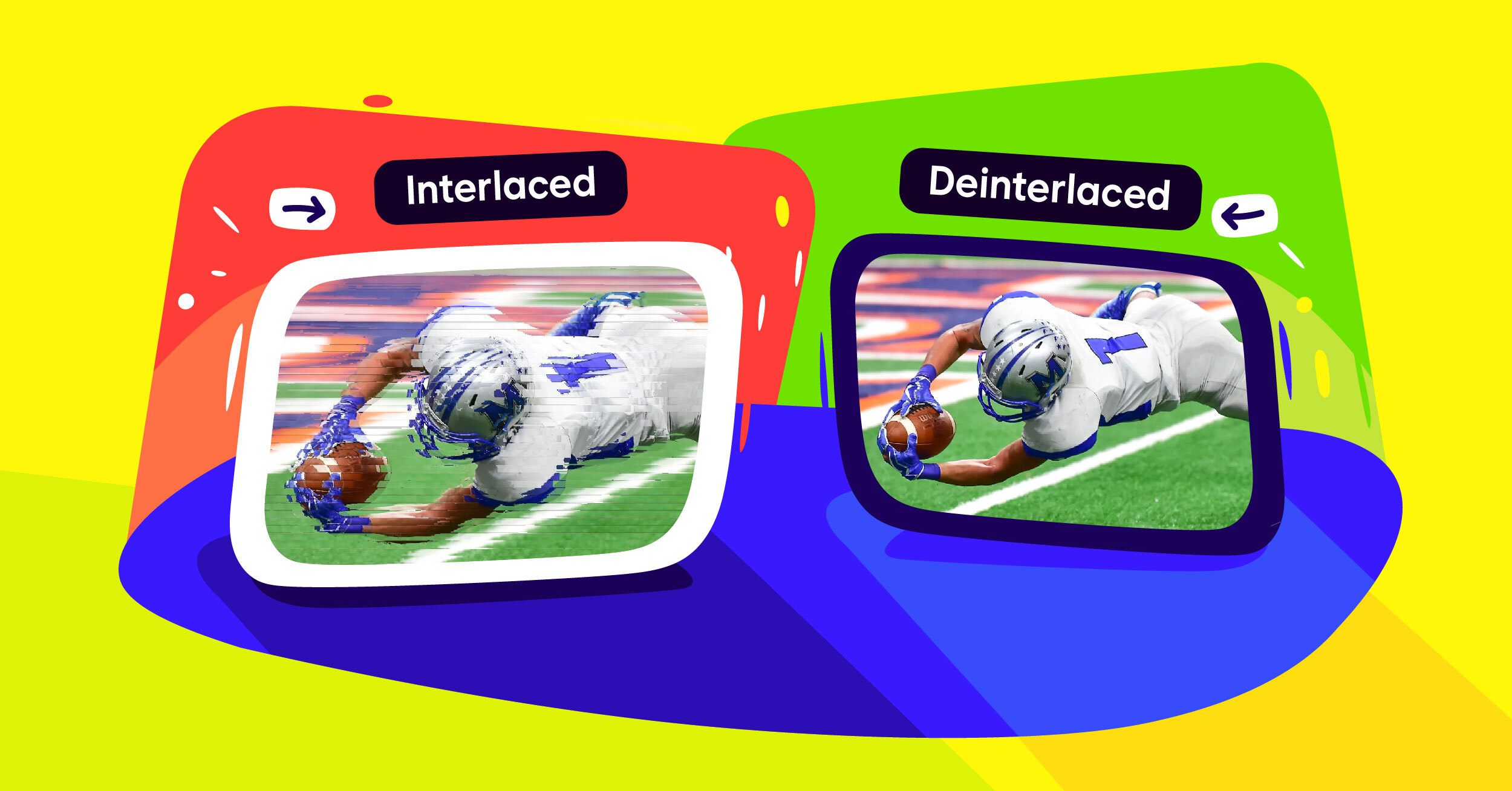Have you ever noticed horizontal lines or a flickering effect when watching a video? This could be due to displaying interlaced video, a method that was once popular for broadcasting television signals. Interlaced video displays even and odd lines alternately, effectively halving the vertical resolution in a single pass. This can lead to visual artifacts, especially when fast motion is involved. For example, when captured in interlaced mode, a football might appear jagged or blurred in sports broadcasts.
Regarding streaming, it’s essential to deinterlace video to ensure a smooth and clear viewing experience. Deinterlacing transforms the interlaced video into a progressive format, which displays all picture lines in every frame.
This blog will delve into the differences between interlaced and deinterlaced video and will guide you through deinterlacing your streams using Castr for optimal video quality.
What is an interlaced video?
An interlaced video is a technique used in video displays to double the perceived frame rate without consuming extra bandwidth. This technique was developed approximately 70 years ago and was prevalent before digital televised content. Its purpose was to make the video appear smoother while transmitting less broadcast-related data.

Interlaced video involves capturing two fields of a video frame consecutively. Each field in the image contains either odd-numbered or even-numbered lines. These fields work together to create a full frame, effectively doubling the time resolution compared to non-interlaced footage.
Interlaced video displays images on a screen by alternating lines- e.g., picture a loaf of sliced bread, where each slice is a line of the image. Instead of showing all the slices at once, an interlaced video would first show only the odd-numbered slices, then the even-numbered ones. This happens very quickly, so our eyes blend the two sets of lines together to see a complete picture.
For example, older TVs used interlacing to show a program. The screen would refresh so fast that viewers wouldn’t notice it, only showing half the picture at a time.
However, this method can cause problems with today’s playback methods. When you watch interlaced content on modern screens that don’t support interlacing, you might see a flicker or lines across the image, which can be distracting and reduce the quality of the video.
What is progressive video?
Progressive video is a format where each video frame is shown in full, one after the other. This differs from displaying interlaced video, where each frame is split into two fields shown separately to create a complete picture.
For example, if you’re watching a show in progressive video at a frame rate of 30 frames per second, you’ll see 30 whole frames each second. In interlaced mode, you’d still see 30 frames per second but 60 half-frames (fields) combined to make the full frames. This can sometimes cause a flickering effect, especially during fast-moving scenes. Progressive video provides a smoother and more precise viewing experience, especially on modern displays.
Interlaced vs. Progressive video: Which is better?
Interlaced and progressive are two methods used to display video content. Interlaced video divides the image into two sets of lines – the odd and even ones. It first shows the odd lines on the screen, then the even lines follow. In contrast, progressive video displays all lines of the frame at once, in order, making both odd and even lines appear together.
Interlaced video can make it seem like the frame rate is doubled, even though it doesn’t add more detail to the picture. Meanwhile, progressive video provides a smoother and more lifelike motion.
Back then, interlaced video was common for analog TV broadcasts and some DVDs because it saved bandwidth when there wasn’t much to go around. Nowadays, with less bandwidth, progressive video is the preferred choice due to its higher visual quality and better compatibility with current technology.
Progressive video is the top choice for watching videos today because it makes everything look smoother and clearer, especially when things are moving fast on the screen. It doesn’t flicker like the old interlaced video. It’s easier on your eyes and works great with modern TVs and computer screens. Back in the day, interlaced video was used because it saved space, but now, with all the advanced technology and faster internet, progressive scan is the way to go for awesome video quality.
What is a deinterlaced video?
A deinterlaced video is a type of video content converted from an interlaced format to a progressive format. Initially, video from interlaced sources splits each frame into two sets of lines, which are then merged to display one frame. This method was useful for older televisions but can cause problems when viewed on computer monitors, which are a progressive medium. They display video content as complete frames, showing each line of pixels in sequence.

Deinterlacing combines the separate lines from an interlaced source to create a single frame. This process improves the quality of the video when it’s played on progressive displays, making the movement look smoother and reducing flicker. It’s an important step in video compression and streaming, ensuring the video content looks clear and stable on modern screens.
Why Deinterlacing is Important
The importance of deinterlacing comes into play when interlaced video is viewed on progressive screens, such as those on computers, smartphones, and modern TVs. The video can appear blurred or flickering without deinterlacing, especially during fast-moving scenes like cricket or football matches. This is because the progressive source is designed to display all the image lines simultaneously, not in separate fields.
When streaming video content, deinterlacing ensures that the quality of the image is maintained and that viewers have a smooth and clear viewing experience. It removes the lines that can appear across the screen and prevents flickering that can distract from the content being watched. By converting interlaced video to a progressive format, deinterlacing helps make old and new videos look their best on today’s wide range of devices.
Smooth Out Your Streams: Discover Castr’s Deinterlacing
Interlaced video was a standard in older analog TV systems, but as technology has advanced, the need for clearer and more modern video formats has become evident. Modern digital displays require videos to be in progressive format, meaning each frame is displayed in full, one after the other. This is where deinterlacing comes into play. Deinterlacing is the process of converting interlaced video, which contains alternating sets of lines in each frame, into a progressive format.
Castr steps in as a complete video streaming solution that tackles this issue with ease. With its cloud-based transcoding capabilities, Castr can transform an interlaced video into a progressive video, ensuring that your content is compatible with contemporary digital displays and provides a smooth viewing experience for your audience.
Castr isn’t just about deinterlacing. It’s also known for its robust video streaming features. Adaptive Bitrate (ABR) streaming and live transcoding are just a couple of the advanced features that make Castr a popular choice for content creators and broadcasters. ABR ensures that your viewers receive the best possible video quality their internet connection can handle, while live transcoding adjusts the video in real-time for various devices.
If you want to bring your video content into the modern age and provide your audience with the best viewing experience, give Castr a try. With its powerful deinterlacing feature and other streaming capabilities, Castr can handle all your video streaming needs. Try Castr today and see the difference in your streaming quality.









